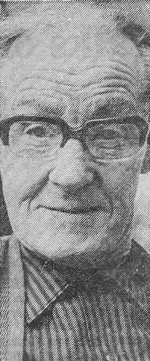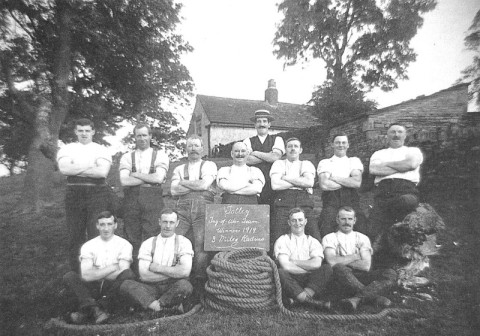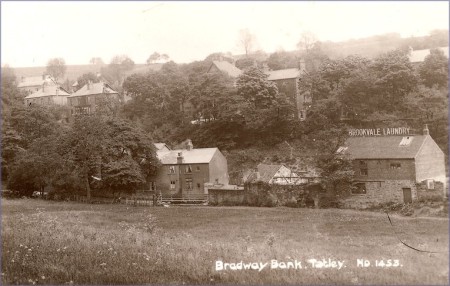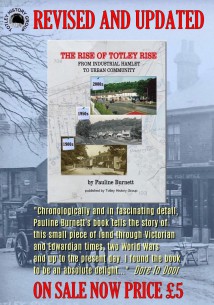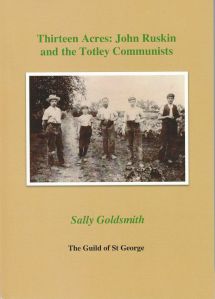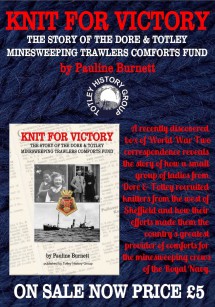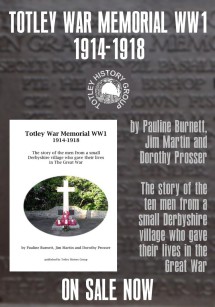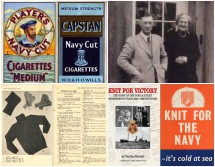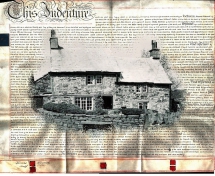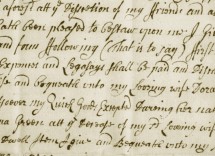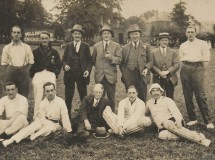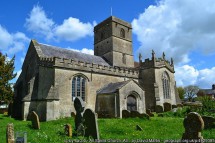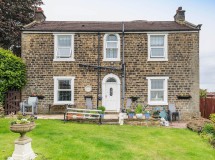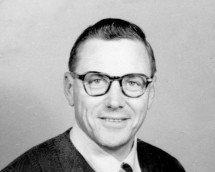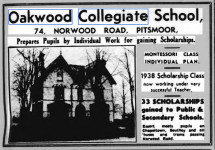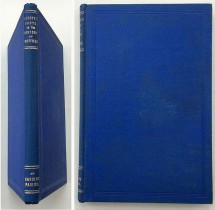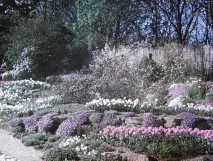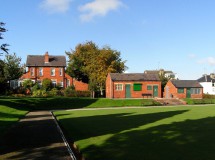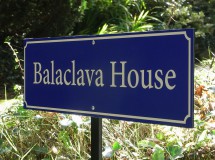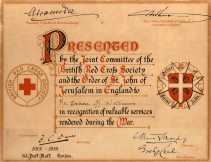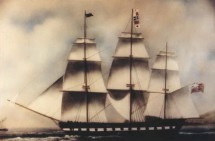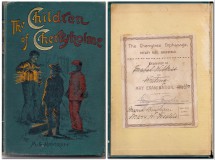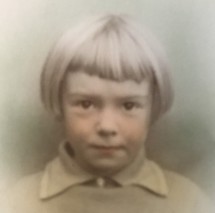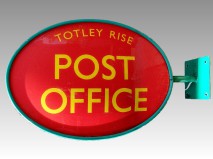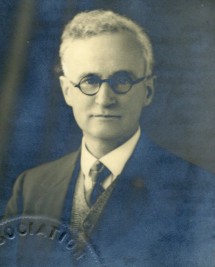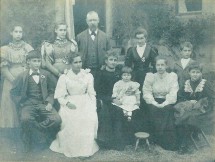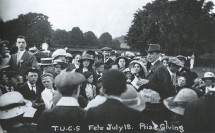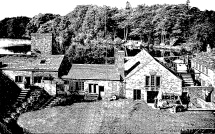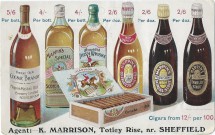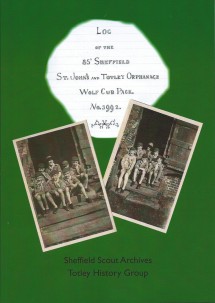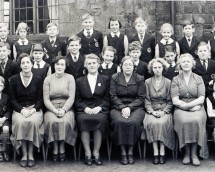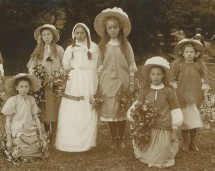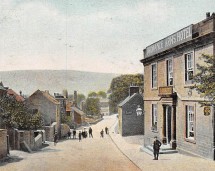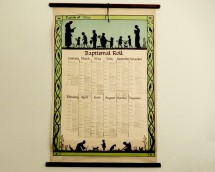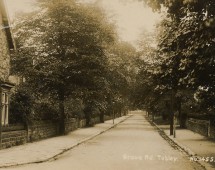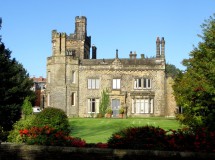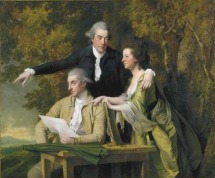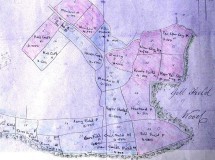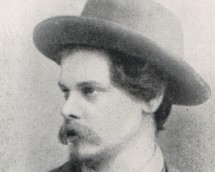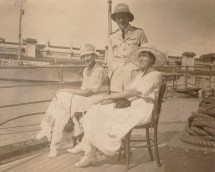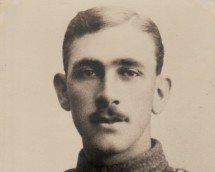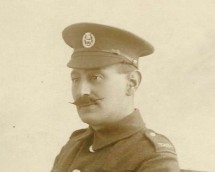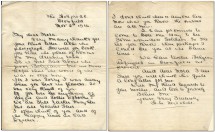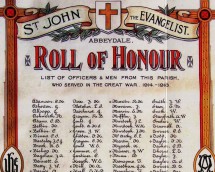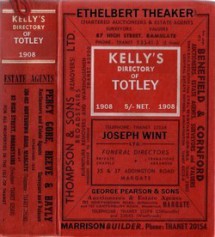The Memoirs of Dan Reynolds
George Daniel Reynolds 1910-2009
(Dan began writing his Memoirs around 1976 but this version appears to have been written between 1983 and 1995).
Part 1.
This is a true story of my life from when I was six years young, spent in what was a lovely village. There were persons of whom I like to think of as characters, not that they did anything deserving honours, but were typical of life in those days.
It was the year of 1916 and the Great War was in progress. This was very apparent in Totley as it was like a small garrison town. Soldiers came by the thousand to do their gunnery training on
the rifle ranges, also wounded soldiers from the front line in France were brought to the field hospital (recreation ground fronting Cricket Inn) for treatment. St John's Hospital on Abbeydale
Road (now postal sorting office) was the operating theatre for severe cases, and were then transferred to the field hospital on recovery. A Dr Dick Evans, a member of the American Consulate,
was a frequent visitor to the sick bay at Totley Bents, where I understand he was able to offer his valuable expertise. I gathered most of this information from his daughter Cornelius, who at
the age of seventy two came from America to visit the place and home of her birth, which happens to be where I have lived for fifty three years.
That was about ten years ago, and though we started corresponding, the letters ceased to come, but she was able to tell me a lot about her family. Apparently, when war was declared she was sent back to relations in America; her father and two brothers didn't go with her, she did not know why. The brother I remember was called Richard and, like a lot of the lads, was a real daredevil. It was not until her father and brothers returned to America that she was able to acquire the information on the hospitals. This was, of course, after the armistice.
The rifle ranges at that time were spaced at every hundred yards. At nine hundred yards, just inside the field, left hand side of Lane Head Road, they practised with the Gatling and Lewis machine
guns, and of a Saturday and Sunday they were watched by many grown ups and we children. To us it was fantastic, but to the grown ups it must have been traumatic.
As happened during the 1939 war, it was compulsory to billet members of the forces if you had the room available. Any buildings which were spare were used to stable the horses, so as you may gather, the friendship between civilian and soldier was simply grand.
Offset from the range was the camp where many bell tents and marquees were erected. These were what the soldier used as his home during training. Eight, or even ten men to a bell tent! There was a specially built swimming pool where they were able to take a bath, and most likely to do any washing. There was no supply of water: the pool relied on water from land drains, and surplus water eventually found the stream. The narrow lane opposite the entrance to Monny Brook Farm leads to the stream, and on close examination you will find an iron pipe with running clear water, which was carried from here to wherever. I would imagine the water supply to the pipe was from a spring in the vicinity. Up to around 1975 this was the only water available for the tenants at Monny Brook Cottages, the last tenant being a Miss Diana Burgess. These were sold, demolished and then rebuilt.
As I understand there were many springs in times past which supplied water for the population. A friend of mine, Willis Pearson, was told by his father that there was a well at the rear of 5 Hillfoot Road, and it was his great-grandfather's duty, twice a day to unlock the cover to the well, and the womenfolk would come along to collect water.
There was also one on Summer Lane, and according to Arthur Turner this
was continually over-flowing, and he and Fred Fox were detailed to concrete over the well. Yet another which I remember in use was in Hall Lane which was protected by an iron gate, and I most
remember its use when the steam roller, which maintained the roads, was used to lower a pipe into the well to pump water back to its tanks.
During the years of war we children were interested by the searchlights probing the skies for any aircraft, presumably Zeppelin as it found its way to Sheffield and, I am told, dropped bombs on
Skelton Works which I think was in the Heeley district. No doubt data can be found on this in records at the Town Hall.
Part 2.
Life in those days was very hard for our parents, in fact you could describe it as just an existence. The employer was able to call the tune and the employee had no defence. The wives must have had a very trying time making ends meet, what with food and clothing for man, wife and children, of which there would have been five or six in many households. Looking back I often wonder how my mother, and many like her were able to keep going. You can only say it was dedicated love for the children. Just imagine, her day would start at 6 o'clock in the morning till up to 12 o'clock at night, washing, cooking, baking, ironing, mending etc, and during all that time she would have very little rest, and yet was able to find the time to help a neighbour during illness or whatever.
A great friend of my mother was Mrs Holding, who lived in a house opposite Shrewsbury Terrace where we lived. I often meet her daughter Mary (Mrs Pearce), and she remembers the times my mother would help her mother with the wall papering and sewing, and besides payment she would give her eggs and a boiling fowl. She was most certainly a good friend, and I'm sure the same was said of my mother by Mrs Holding. This was typical of the small community spirit of those days; what a pity that this is lacking in the way that people choose to live today.
The first thing the wives had to do in the morning was to light the fire, which was the only means for boiling water and cooking. The fireplace, or range as it was called, was a Yorkshire range of which there were different types, but every cottage and the so called gentry had this kind of range. It was a fireplace, with its fire in the centre, hot water boiler to the left, and over to the right was the oven, and above there was a plate called a hob, where meals could be kept hot. The fireplace was surrounded with stone slabs, on the top slab there was usually a wooden mantle shelf decorated with a chenille cover, which would hang about nine inches deep. These were of varying design and colour and looked beautiful.
After meals a table cloth covered the table, this was also chenille. The stoves were black- leaded two or three times a week and they really looked grand. The fender would be brass or burnished steel with fire irons to match, and believe me; when they were polished, which was every Saturday morning & they looked superb. I suppose you could say it was a pride and joy to the room, when you come to think the stove was always warm due to the fire burning in the region of sixteen hours a day. In fact, the porridge (main breakfast dish) was placed in the oven at 10.00 p.m. and would cook overnight.
Monday was the big wash day. A big pot in the corner of the kitchen was heated by a small fire which was just over half filled with water, when boiling soap and clothes were thrown in and the woman would agitate them with a round stick. When ready they were transferred to a dolly tub and a peggy leg would be used to stir them.
Afterwards with added soap they were rubbed up and down the rubbing board then to the sink to be rinsed with cold water, finally to the mangle where they were fed between wooden rollers and turned by a wheel, then hung out to dry: this depended a lot on the weather. They must have had muscles like buck navvies after that, but they didn't flinch or grumble, no it was just another day.
The floors downstairs were stone flags and these were covered with cheap lino and hand pegged rugs. Many are the times we kids would help our mums to cut up the material, anything was used - old coats, trousers and such were cut up into strips about 5" by 3/4". With a hooked awl they were laced into the webbing (webbing is hardly the right name as it was a sugar sack purchased from the grocer). The rugs varied in size but the one in front of the fire would be about 60" x 30" and were very heavy. Every working class household had these rugs, upstairs it was just lino.
Money was scarce, wages were low and everyone lived on the breadline, but it was an accepted way of life. We were happy, brought up properly, discipline was strict at home and at school, we made our own entertainment and were far from being bored. Bored is a very much used word with children and teenagers of today, and this is not entirely due to unemployment but due to parental upbringing.
There were no toilets, hot running water, sewerage, electricity or gas in the cottages rented by the working class. 'Middens' were used for two purposes, at the rear was where the ashes and
refuse were thrown, and at the front was where you relieved your call of nature. `Cesspools' were for sink waste, and lighting was from paraffin lamps which varied in design and fixture.
Some hung from the ceiling, but most were free standing. They were made of brass, and once again added brilliance and charm to the room.
These lamps had glass chimneys and, of course, accidents would happen, and when one did break we had to walk to Dronfield Woodhouse to the home of the travelling hardware man by the name of Mr T Gillespie. He came once a week and sold paraffin soaps (carbolic), fuel and whatever, you name it and it would be on his dray.
In those days if your parents, especially your father asked you to do anything you obeyed or woe betide you. You only refused once, when off would come his leather belt and two or three strokes round the legs made you realise who was the master. That was discipline, it was a way of life and you took it in your stride.
The same discipline was metred at school, only with a cane by the Headmaster, Mr John Wood. At the time it really hurt but was appreciated in later years. Mr Wood was a very strict disciplinarian and as headmaster he ruled the pupils' and teachers' lives at school. There were a few times when punishment was administered because he would not listen to an explanation.
One instance that sticks in my mind was when I was five years young and in the infants. It concerned a boy called Muggy Belbin (Muggy was a nickname which was common with boys and girls), who lived in Bradway Bank. It was winter time and he and his pals were snowballing each other as they approached the bus terminus at the Cross Scythes. Just as the passengers were walking away from the bus, who should be there but Mr Wood and Miss Crookes, the infant teacher, who always wore those big straw hats decorated with flowers and fruit, and held in position with long hat pins. Well, the inevitable happened; a snowball hit her hat, probably causing a little discomfort. After assembly at school, despite the fact he owned up to throwing the snowball and apologising in front of the children for the incident, he was caned on his legs and paraded in front of each class. I can picture him now, his face streaming with tears. Mr Wood did not accept his explanation. In this case it was pig-headed discipline, but having said that I'm sure we all admired him.
I remember when we reached the age of around eleven and was able to join a competition called the `Bird and Tree'. A number of pupils were selected to study and make notes of a bird and tree of
their choice over a period of twelve months.
After that period we were given one day each for bird and tree to write down our observations under the scrutiny of Mr Wood and a member of the trust. The school was closed, except for the competitors. This competition was organised by the Royal Society for the Protection of Birds, for which I still have a medal. For some unknown reason this no longer exists, which seems wrong because it kept us very much in touch with the wild and plant life, and had there been the same interest today, who knows, it could well have a bearing on conservation in this area.
Our schooling was at the C of E School, and children in classes Six and Seven were able to study for a place at Dronfield Grammar School, then called Henry Fanshaw. If you passed with full honours, education and books were free, but for minor honours just education was free. Up to a few years ago pupils at Totley School, when sitting for exams, were able to name Henry Fanshaw as first choice. Whether this choice remains I know not.
The C of E School was also the place of worship for protestants, and the Wesleyan Chapel (now a residence) for the Methodists. Both were well patronised by young and old. The services
were conducted at the C of E by an ex-army chaplain called Captain Faggerty, and lessons read by Mr A J Foulstone. The latter was a very dedicated man in whatever line he pursued, and always
seemed to be in a hurry in all his activities. A great man who should never be forgotten.
The Sunday school for the little ones was cared for by Miss Harris, who at the time of writing is a resident in a private nursing home. Again, a person who performed a good and valuable service for the youngsters, she also gave piano lessons. There were others who assisted at the school, but Miss Harris and Mr Foulstone are the two I will remember for their love of activities that brought much pleasure and religious teaching to children and parents.
After the war ended a memorial to those killed in action was erected, also a club was formed for ex- service men. Many local stone masons were employed in the building of the war
memorial. Horatio Taylor was one I remember. The name plate is headed by R Milner who was the son or Mr and Mrs Milner of Totley Hall, so you would assume that was reason enough for his
name to head the list, but according to an old friend of mine, Joe Marshall (who furnished me with a lot of information), Roy Milner was the first volunteer and also the first to be killed in action,
so it had nothing to do with his, or his parents' status in life, and knowing Joe I believe that to be so.
The memorial is on land adjacent to Baslow Road which many years before had been used as a tip. This piece of land, the school playing fields and the allotments belonged to the church (Dore), and rents from such were part of the vicar's living. I feel sure the field next to the Cricket Inn also belonged to the same church authorities.
The club was one-storey stabling of the past converted to a two-storey building with a flight of steps leading to the club, the lower part was for storage and vans. This and surrounding
properties were owned by Mr Evans, the grocer. Both he and his wife were grand people to know, caring and understanding and without doubt earned them a lot of respect from the working class who
purchased at the shop. Purchases would be paid for on a Saturday after the man had handed his wages to his wife. No doubt tick (credit) existed so I would say profit was not the objective when
the club was built.
Part 3.
Around this time we boasted a very good tug-of-war team and were unbeaten in a radius of three miles, and when I say there was some very strong competition from very strong men, I mean just that. The one determined factor for our team was the Coach, Constable Bagshawe, who trained them twice a week in the field at the back of Cannon Hill Farm, (see photographs of them in training and when relaxed).
The ages of the men would be early forties and what a fine body of men they were. As I remember they once took on a team picked from the army troops at the rifle range and each were rewarded with a
cut-throat razor which were inscribed to mark the event. Unfortunately all seem to have been lost. The rope, as used when training was loaned by Tennants Brewery.
The Totley Tug O'War team in 1919, posing with knuckles pushing out the biceps, after winning the trophy against villages in a three mile radius. From left to right standing: Joe Marshal (worked for Totley brickworks digging for ganister on Fisher's Moor off Strawberry Lee Lane), Israel Salt (in charge of the mine), Tommy Duddy (worked for George Creswick senior at Cannon Hall Farm), Tom Wright (landlord of the Grouse Inn at Totley Bents), Billy Gascoigne (traction engine driver for the brickyard), Straightback Bagshawe (trainer and village bobby), Joe Hillman (a 'comer' who replaced Frank Taylor because he was living in Holmesfield at the time and was thus not eligible) and Tom Reynolds (father Dan). Front row from left: Jack Wortley, Oscar Creswick, Duncan or 'Hunkie' Coates (7th son of a 7th son, worked down ganister mine), George Pearson (market gardener at St. George's Farm).
There was quite a lot of interest in affairs in most villages, but I can only speak for Totley. There was a garden produce show and sports event every year. Prizes were donated by local business men; many first prizes were solid silver. The produce show was for allotment holders only, but one person who shall be nameless was allowed to exhibit his produce, even though he was not a holder, but I admit that he had a garden near his home. His garden was very private so no-one was able to pry or do any scouting. Whereas on the allotments competition was keen and you had to be sure about your chances.
Anyhow, to cut the story short, this person won many first and special prizes, and it was assumed he had cheated, so as the saying goes "If you can't beat `em then join `em'", which is exactly
what my dad did. Come the next show my dad's exhibits romped away with the first and special prizes. I became involved in this through my interest in our allotment. The Wednesday
before the show on Saturday was choir practice at Dore Church, where I was a choir boy. I was told to call at the house of Dick Wragg who lived in Drury Lane, Dore, and say "Mr Reynolds, my dad
has asked me to call", whereby he gave me a cardboard box and said "Mind tha dun't knock `em abaht and tell thi dad to let me 'ave `em back when tha comes to church on Sunday". I did as was
instructed, delivered the parcel to my dad then returned the package on Sunday. Dick Wragg said "Good lad, I'm tekkin' these t'Daily Mail show next week". It turned out that the package
contained six potatoes called 'Arrun Banner' which were first class.
Part 4.
The sports events were a great attraction for us kids, and took place in the field in the area of Totley County School which was owned and loaned for the day by Mr Tom Earnshaw of the Grange which was opposite. Although I remember taking part I never remember winning a prize, but it was still great fun. The older kids, that is, the teenagers, entered with a competitive spirit as there were good prizes to be won.
The main event, except for the tug-of-war, was the steeplechase which commenced by running once around the field, through the gate, up Baslow Road, down Hall Lane using the footpath to Woodthorpe
Hall, then on the footpath through the fields to Mickley Lane, up Mickley Lane to Baslow Road and continuing to the entrance of the show area, once again around the field then to the finishing
tape. The prize was a solid silver cup about fifteen inches high and was donated by Mr Tom Newbould, who was the first developer of Heatherfield - more of him later. He made a bold
stipulation that the winner retained the trophy for one year only, and had to be won three times in succession before the winner could claim it outright. It was eventually won by none other
than that great Totley athlete, Archie Thomas, but not before the two brothers, Neville and Fred Marshall were inscribed on it.
The pity about this cup was, and I make no bones or pull any punches, is that in later years Archie had the inscription erased and donated to the Hope Valley Football League. To me that was very unjust, and I feel if Tom Newbould had foreseen this he would have had second thoughts. Some of you didn't know Tom and his interest in Totley, and that this trophy was for a running event, and could now have been the trophy for the local Reu Race which takes place yearly.
At this point I must refer to Frank Taylor who devoted a lot of time to the youth of the day. It was way back in 1920 that he persuaded many of the local young men to start keeping pigeons with
a view to racing them. They did so, and very successfully, by flying from as far as Tamworth. Frank belonged to a pigeon society, and flew his pigeons from abroad and won many
trophies. In 1923 he persuaded the athletic types to practise and join Sheffield United Harriers and Athletic Club, the three foremost were Ron Hoole, Herbert Green and afore-mentioned Archie
Thomas.
A few years later the show and sporting events collapsed due to the introduction of non Totleyite committee men who introduced fur and feather. Prize money far exceeded funds for prizes and you sensed what would happen. So that was the end of what may today have been a big attraction for residents and outsiders, as now happens in some villages in Derbyshire.
The TRA do a very good job, also the Crown Inn in trying to help the residents to revitalise the spirit of young and mid-age, but the response seems ignored. Here we have a much populated community with almost no facilities at all, which seems incredible to me after how much others and myself attained in our lives. The sports club still exists on small funding, not forgetting that the sports ground at Totley Bents was free and able to take collections; they are not allowed to do this now but have to pay Sheffield Corporation a fee for playing cricket and football, which prompts me to ask the question "Why, when this is a kind of common land, and who gave Sheffield the right to maintain this area?" Though this description has brought me up to the present day, I felt it had to be mentioned as a comparison.
The Ex-Service Mens Club which was founded was later taken over by Totley Social Club, and as lads of fourteen and over it was a good meeting place. There were card games and two billiard
tables on which tournaments were held every year to decide who was best player. A cricket team and football team were also started. The subscription was one shilling (5p) per year, which
was half of our spending money. We fourteen year olds got about two bob (10p), so we were not able to use the billiard tables as much, but we were happy and contented. The steward, Billy
Drury, was a very dedicated man and used to hound us on pay day (Friday) if we owed any money. His sister, Lucy used to keep the place clean and I feel sure their services were free. As
happened with the show, new members were elected on the committee. First one and then the other billiard table were disposed of to make way for Whist and Solo drives until eventually it was
closed.
The social club's governing bodies at that time were Marriot Fox, Fred Fox (no relation) and A J Foulstone, and we looked on them as three old fogies. Although I admired and had great respect
for the latter they were behind the times, hence the word 'fogies'. Opposite the club house is Cross Grove House where lived a Mr and Mrs Milnes who were moving house, and through their
interest in village life offered the committee first refusal to buy, but it was turned down. It could well have been the social club's headquarters with space at the rear for activities.
I may be wrong, but I feel sure there were a few people in Totley who would have sponsored this venture had they been approached, as was proven when the Totley show operated.
As I mentioned, we lived in Shrewsbury Terrace where the rent was nine shillings a fortnight (45p). Next door was Cannon Hall Farm, the tenant being Mr Fred Creswick who had two daughters, Ida
and Marjorie. We were all play pals so spent a lot of time at the farm and in the fields, but what I remember most was of the night times when we used to go and help Tommy Duddy pulp the
turnip, cut the chaff and cut the cow cake. After the turnips had gone through the pulper it came out exactly like potato chips, the hay, which went into a chopper came out in half inch pieces,
and the cow cake with slabs around twenty seven inches by twelve inches came out cubes of one inch. These machines were operated by a wheel around thirty inches in diameter and turned by a
handle. The turnip and hay were mixed to make lick to feed the cows, they were fed the cake separately. We spent hours there and enjoyed every minute.
Our parents purchased milk from the farm where there were two kinds - old and new. The old was cheaper as it was what was left after having had the cream skimmed off. When a cow calved and the milk was too rich for the calf we were given that free - it was called 'beastings', yellow in colour, and made fine custard.
When they killed a pig, which would be a sow, the menfolk in the terrace would assist and what a spectacle it was to watch. The butcher, Jack Wright, would go into the sty and thread a noose inside and over the snout to make sure its mouth was tightly shut, and then very reluctantly it was hauled and pushed to the scratch, a kind of table about twenty inches high, two foot wide and fifty four inches long. On either side the outer frame extended around twelve inches which formed handles for carrying when taking to hang after being scraped. It was no easy task getting the pig to the scratch and the even bigger problem was lifting it onto the scratch.
When each man had made sure he had a firm hold, the butcher inserted the knife into the jugular vein, it was then that the men were able to demonstrate their muscle power. We kids kept our distance on top of the wall and thought it great fun, but thank God more humane methods are used today.
After having been hung for a day the pig was cut up for ham shoulders and belly bacon (after salting), the fry and head were given to the men, which meant we had a feast of a time - so to speak. We would blow up the bladder and use it as a football, that is if my dad didn't get there first because he used to hang it up to dry then shape it for a tobacco pouch. The intestines were cleaned by water under pressure which turned them inside out, the bag was done likewise and all was good eating. They say nothing is wasted on a pig and that is so, except at the farm they put the blood vein to waste - happy memories to me!
Our activities in the winter, apart from snowballing and sliding was sledging on Older Dam where we had lots of fun. Those of the men who could skate would skate on the dam, which is now filled in and grassed over, but fortunately evidence to prove it was a dam remain. It was said that the dam was dangerous, at the shuttle it would be around ten foot deep and at the other end at the bottom was sludge. I never remember of anyone having an accident so we were probably lucky.
Part 5.
There were a few who typified with life in a village, such as Jimmy Larder, Jack Slack, John Osboume, Jack Fox. Of course, you can't help but mention Joe Marshall for whom I have extra respect. Jimmy Larder used to ply a horse drawn service between Dore and Totley rail station and Totley, or wherever. The state of the roads were rough and many pot holes were encountered. Miss Harris had contributed a small article in the Totley Independent saying how she had made the journey from the station to Totley and what a rough ride it was, especially when a wheel dropped in a pot hole. I remember he used to bring water cress to our house, whether this was a little sideline I don't know. He was a small, smart man who was always pleasant and operated the service when the wagonettes came through Totley on their way to Derbyshire.
In later years, Sheffield Corporation ran a double decker bus service from Millhouses to Totley, (Cross Scythes). The roads were much the same except the pot holes were not as common but still
a rough ride. They were open top deck and behind each seat was a rainproof cover for you to use as protection when raining. Three men were allowed to sit alongside the driver and the fare
was tendered through a pigeon hole in and above seating. The wheels had solid rubber tyres, and always on reaching Cross Scythes the driver used to refill the radiator with water.
This service proved to be a godsend for the working class as our parents, mostly our mothers, were able to board a bus at Totley to Millhouses and then board a tram car to town and the market - the old rag and tag, where great savings were made on purchases. Mind you it was hard work for the women walking from stall to stall making a purchase with the bags becoming heavier, though once returning home they never complained and very little help was offered by the menfolk. Such were the times, ways of existence and duties a woman conformed to once she married.
Jack Fox, a big chap who in his later years lived in a hut at the rear of number one tunnel shaft, would always be seen with his faithful dog by his side. He was seen many a time poaching, and
apparently paid the penalty when caught. He never married, and though he spent a lot of time at his parents who lived at the old cottage to the right of the Cricket Inn, I have a feeling that
there was no love lost between them. Though not a popular man, I found him interesting and a pleasure to talk to, and he never condemned anyone, which says a lot for village life where chatter
and gossip took place. He was quite a different chap to the 4 already mentioned both in character and disposition, but again I admired Jack.
We now come to Jack Slack, but before referring to him I have to explain how his main function in our life came about. In the days of my early childhood, there was no gas, electricity or sewers, just cesspools and middens were cleaned out every fortnight. This is where Jack comes in as it was his job to jump in and shovel the garbage and such into a tank type of horse drawn cart, after which all was swept and a generous amount of powdered disinfectant was strewn around.
I was never interested in -finding out where this was tipped, and to this day do not know of any tipping area. ' It was never understood how a man like Jack was doing such a distasteful job. He lived rough, much the same as Sweedy in farmers barns, but his mannerisms, vocabulary and his respect of others befitted any learned man, always tipping his bowler to the womenfolk, addressed the menfolk and always greeted you with the time of day - a true gentleman. It was assumed, though he would not give any inclination, that he belonged to the aristocracy and maybe differed with his family as to the way working class were exploited. The clothes he wore were all given to him, and more often than not his shoes were much the worse for wear.
He was very much respected in Dore as he spent much time there and would help the gardeners in Dore Road. Here were the homes of many Sheffield industrialists. You would describe it today as the millionaire belt. After having him to talk to you, you could not help but like him - a great chap, but alas ill health claimed him and it was thought he would be buried in a paupers grave, but they were mistaken. The residents rallied round and he was given a proper funeral. I was in the choir at Dore church on the day of his funeral. He was given a full service and the church was packed with mourners from all walks of life. On coming out of the church to the burial, I had never seen as many flowers and wreaths in my life waiting to be placed in the grave. It would be nice if anyone had a photograph of this mark of respect for a true gentleman.
As I said, I was a chorister at Dore church, the choir master being a Mr A Farnsworth. The dress for service was an Eton jacket, pinstripe trousers, white shirt with deep white stiff collar,
black tie, shoes and socks. For services rendered, we were taken for a day trip to the seaside. Once we were taken to the Wembley Exhibition. At Christmas, we had a party in the old
school (opposite the war memorial), and afterwards were presented with an annual of The Scout, Chums or Boys Own. Inside, was a piece of paper on which were three addresses of the people who
had contributed to the prize. We were expected to write to the people concerned thanking them for the gifts and also their support to the church. I am not alone in assuming that the
funding for our dress as choir boys, trips to the seaside, plus the funeral for Jack Slack was met by these people, who more or less all lived in Dore Road. Never will that class of people be
repeated, I'm sorry to say.
Joe Marshall was a very good friend of mine and was able to give me much information, especially with regard to common land of which Totley has three areas. Two are quarries and the other one, as we
all know, is the peace garden adjacent to the C of E school. We all must be grateful to Stan Bingham, his wife and helpers who toiled week in, week out to transform this tip into the picture it
is today. The stone troughs which are the original troughs used when it was a pound for stray animals, were located and lifted by a heavy crane. The area was bigger until it was decided
to make it a drive to the old Wesleyan Chapel.
The two bench seats already there are in honour of T Sampey and Frank Taylor. I am told Mr Sampey's son made a generous donation to the project. I along with others cannot see why Frank
Taylor was chosen. I feel they did not do enough research otherwise they would have chosen Mr A J Foulstone, a great man who devoted the better part of his life to the community. I
admired Frank for his sporting interests and devotion to whatever for the young men of the day, whereas Mr Foulstone's interests were spiritual. His daughter Freda was a school teacher at the C
of E school and now lives at Baslow.
One of the quarries, of which there were two, was situated on the right hand side of Baslow Road, just inside the border of Derbyshire and South Yorkshire which is now used as a tip for road
materials by Derbyshire County Council. The other one is at the end of the narrow lane opposite Monny Brook Farm entrance, where we were allowed to quarry stone for our own use. Joe
Marshall and my brother Richard Reynolds, who owned the farm quarried a few times to repair walls at the farm.
The recreation ground at Totley Bents was left to the people of Totley and near districts as a playing field. You were able to graze geese and donkeys, but no cloven footed animal. The
deeds pertaining to these four areas were deposited in the vestry at Dore church, and by appointment would be allowed to see them. The last time I made enquiries about these I was told that
they were in the safe keeping of Wilson Solicitors.
Frankie Fisher, who with his brother Bill and two sisters, lived at the Old Field Farm. He was a chap who lived by his wits and would often be seen in the village selling a rabbit or some eggs, and
if anyone wanted a chicken he would oblige. He was a real wily bird, always dressed reasonably well and smoked a clay pipe, often upside down. He had a walking stick which he called his
ash plant and wore a coat which was probably made in the first place for a "beater". They were men who used to drive the game towards the guns and these jackets, which almost reached the knee,
had big pockets inside which most certainly were used to place game which the dogs had failed to find.
On a Sunday, the wagonettes used to take trippers into Derbyshire, and what a grand sight to see the four horses in hand come rattling by, and I mean rattling on the limestone road surfaces. No doubt after one or two trips, the backside was numb.
The Cross Scythes had every indication of having once been a coach station where a change of horses took place. It had under cover stabling for at least eight horses, complete with hay racks
and two big stone drinking troughs. There was also a farriers shop and a tea room where passengers were able to have a meal whilst waiting for a change of horses. The Cross Scythes Hotel
was first class and really looked the part. There were brown earthenware lions, one at the top and one at the bottom, each side of the stone stairway and one at each end of the rockery at the
front. They were about twenty two inches long and proportionate; the posture was laying down with front legs outstretched. Maybe someone somewhere was able to acquire one, but on the
other hand, as we have seen so often, were probably demolished.
There were five pubs in Totley:
- The Grouse Inn on Totley Bents - Landlord: T Wright
- Cricket Inn - Landlord: O Creswick
- Crown Inn - Landlord: E Snowdon
- Ye Olde Cross Scythes Hotel - Landlady: Misses Swallow
- Fleur de Lys - Landlord: Kirby
The pubs were in great demand when the tunnel was being built and the law had to be enforced on many occasions by the two law officers, Constable Bagsshawe and Sergeant Hall. At the rear of the Sergeant's house were the cells.
There were three shops:
- One Grocer/Baker - Proprietor: Charlie Jackson
- One Grocer/Greengrocer - Proprietor: Walt Evans
- One Milliner/Dressmaker - Proprietor: Emily Green
There was also a Post Office, the proprietor being Tom Bradley.
At the Grocer/Baker (now the Post Office) you were able to purchase dark, medium and light loose treacle. At the rear of the counter were three barrels with a tap and we used to take a stone
jar for whatever amount. Every housewife made the good old fashioned parkin and we kids loved it.
At Totley Rise, there were many shops and led me to think that it was another village. However I could still say what kind of shop was what and who was its proprietor. Starting at the top and working down:
- Marrison Grocer - Wine Merchant and Beer-off
- Thompson Butcher - Home fed and killed (slaughterhouse at the rear)
- Booker - Post Office
- T Wint - Corn and General Dealer
- S & E Co-op - Manager: Moseley
- Cartledge - Butcher
- Wint - Pastry & Confection
- Mottershaw - Sweets and Tobacco
- Roebuck - Chemist
- Greaves - Milliner
- Collet - Fish and Chips
- Theaker - Newsagent - Sweets and Tobacco
These shops had a good flow of business catering for Dore, Bradway and Totley, and even today attract much business.
Down the lane in front of Marrisons, were three houses where lived Mr Scott, Mr Martin and Mr Hawes, the latter being a staunch Wesleyan and rode a tricycle to church and to his employment in
Sheffield. One son of Mr Martin worked for Mr T Wint for many years, and later on operated a newsagent and tobacco business, (now run by his son) at Baslow Road near the Mobil petrol
station.
As aforesaid, Marrison ran a wine shop, beer-off and groceries, and a Mr King, salesman, would come round and take delivery orders which in turn were delivered by Jack Wingle on horse and dray. Thompson butcher was a hard man with his workforce and catered more for the affluent. He owned much surrounding land and his highlight were the Highland cattle kept in the fields, (now Marstone estate).
Frank Cartledge the butcher, was a different person than Thompson, he leaned to the working class and earned much respect. Mr and Mrs Theaker who sold tobacco, sweets and daily papers, were two small people and always jolly. Mr Theaker spoke bluntly and was very amusing in fact - they were both down to earth Yorkshire folk who kept a parrot near the doorway of the living room to the shop.
Part 6.
At the back of the shops at Totley Rise leading to the chemical yard is a lane much used in those days by horse traffic where they had to cross the stream (ford). Pedestrians used the existing footbridge. Once we became part of Sheffield, some blundering idiots in the Town Hall had a low wall built at the side of the stream to stop this traffic, hence we lost the ford.
There were around eight cottages in the chemical yard, and a large two-storey building, where in the past chemicals were produced. It was later known as the boundary called Brookvale. In
the 1920's it was bought by C J Marcroft, a slater and builder, and was used as a joiner's shop etc. It was here that I was employed as an apprentice and earned ten shillings per week for forty
six and a half hours.
The sign Brookvale Laundry, was made of wooden lettering and ran along the ridge. In the basement of the building was a big gas engine and on the walls were many large bracket supports for shafting. A smaller building attached to the main was where Bill Bradbury offered his service as farrier wheel.
Leaving the chemical yard and on the way to Greenoak, you came to Brookvale Terrace where you would find the building of Harry Green's business - joiner and funeral undertaker. A Mr Gledhill
lived in a house nearby and he cultivated the monkey gardens better known as Laverdene estate. Along with his family, he ran a very successful wholesale business in Sheffield market with all
home grown goods, with forced rhubarb being a highlight. His permanent workforce was of three or four and during the school summer holidays about four schoolboys were employed.
My brother and I were employed five and a half days per week and were paid fifteen shillings, which was very, good in the year 1922, as in 1924 I only received ten shillings as an apprentice for forty six and a half hours as I said earlier.
Continuing up the lane with high hedges on either side, you came to Lemont Road where there were four back to back houses. Mr Carr, a smallholder, owned land behind Lemont Road, (now Greenoak
Park). A few surrounding fields which were later sold to C Thompson, who eventually sold to Sheffield Corporation hence the housing estate (enough said!). Continuing up Baslow Road, and
opposite was Greenoak House. A little further to your right was a newly made road leading to Heatherfield which was being developed by Mr T Newbould. Further up to your left is Main
Avenue, developed by Mr Sheard. At the time about thirty houses had been built. Leaving Main Avenue and to your right was Totley Grange, after which you came to the Olde Totley of which I
mostly refer.
The gentry were Mr Tyzack, Mr Ellison, Mr Mills, Mr Adams, Mr Milner and Mr Earnshaw. Mr Tyzack, barrister and gentleman farmer, owned and farmed land at Avenue Farm. He was also a member
of the parish council. His land bordered the narrow lane leading to Dore, and due to some mishap due to the width of it, it was brought up at the next council meeting where he said he would
give the land required at no charge for widening. He was asked if he was prepared to pay for the cost of earth movement which was instantly declined. His offer was therefore
withdrawn. The road is much the same now as then. We were in N E Derbyshire in those days and Derbyshire County Cricket Club played many matches at Abbeydale Park, and in the 1930's
Abbeydale Hall was used as council offices.
Mr Ellison lived at Grove House (opposite the Crown Inn), a grand residence with beautiful gardens and running brook with two entrances, one at Hillfoot Road, the other a private road over the brook at Totley Brook Road. The gardener was Mr Woodfin, who lodged with Mr Bowley at Rose Cottage on Hillfoot Road.
Part 7.
Mr and Mrs Mills who owned and lived at Cross Grove House were really charming people - when they moved house they offered the premises to Totley Sports Club before putting it up for sale. The offer was declined. I feel sure the money could have been found if certain people had been approached.
Mr and Mrs Adams lived at Green Oak House, a nice residence with two entrances, a coach house and stables over which were living quarters for the gardener. The house, coach house and, stables are
much the same today except the ground floor to the house is now shops.
Mr and Mrs Milner lived at and owned Totley Hall, the farm and estate which stretched as far as Totley Brick Works, and also the wood we know as Gillifield. Mrs Milner interested herself in village
activities including the school and church. Many times we school-kids were allowed to visit her gardens and glass houses where Mr Lewis (head gardener) would explain the whys and wherefores of plant
life. We saw very little of Mr Milner as he suffered from bad attacks of gout, but this did not forgive him for the trick he played on his gardener Mr Green, who on reaching pension age was still
employed but the amount of pension he drew was deducted from his weekly pay packet saying it was a tax legality. They employed many staff - Mr Holding the Chauffeur, Mr Thomas the Butler, Mr Bradley
the Gamekeeper, Mr Lewis the Head Gardener assisted by Mr Green and apprentice Master Cook, also about six indoor staff (cook etc). At Christmas Mrs Milner gave us kids two new pennies for carolling.
I guess she was fond of children as her own two boys were grown up, in fact one, by the name of Roy had been killed in action in the 1914-18 war.
Mr Tom Earnshaw lived at the Grange, a residence I always admired. There were two entrances: the one at Baslow Road was half circular with two large stone gate posts. At the sides, about two feet from the ground, were five one foot high wrought ironwork and gates to match. Inside the gate was a lodge which was most likely for the groom, Mr Western, and his family. We assumed it was the groom as a habit was adopted when grooming horses which was to blow hard. This formed a continual habit with him and he was nicknamed `Blower'. His duties after Mr Earnshaw died were general dogsbody and living in tied property. There was little he could do about it, but as long as he was able to visit the Cross Scythes for his pint he was happy.
We kids had plenty of interests - scouts, clubs, girl guides and brownies, and on the Wesleyan side they have Recobites and Band of Hope. We attended them all, religious denominations did not affect
our pleasure. I remember when the scouts disbanded, Ernie Thomas (bugler) was allowed to keep the bugle. We had lantern slides (magic lantern), many of these shows were given by Mr Mottershaw,
who lived at Number 2 Chapel Walk. He founded the Sheffield Photographic Co and was also a pioneer of the movie picture. The shows were held at Totlev C of E School and were
well attended by young and old.
Sunday School sports were held in the fields (now Corporation housing estate). We amused ourselves in all kinds of games - peggy, whip and top, etc for the boys, shuttlecock, hopscotch etc for the girls. We were lucky to get a penny a week for sweets but were never bored. On winter nights we played indoors, board games and a Meccano kept you busy yet relaxed.
At Hillfoot Road lived Mr Dronfield and family who ran a small coal business. Five tons was delivered in bulk, was then weighed by the hundredweight, transferred to strong hessian bags and humped to his customers. This was after having done a hard day's work as burner (firing of kilns) at Totley Brick Works.
At Number 2 Chapel Walk lived a Lady Croft and her maidservant Mrs Graves. One of the maid's tasks in summer was to sling a hammock between two apple trees and when Lady Croft was seated would rock
the hammock to and fro. When a ton of coal was delivered Mrs Graves would ask three or four of us lads to carry it by way of buckets to the coalhouse and we were paid a few pence each.
Mr Green, who lived at Number 5 Chapel Walk, converted an outhouse into a chip shop in later years. Entry was by way of steps bordering the two properties. Mrs Green often used to threaten we lads if
unruly (which I assure you was often - devilishment is more descriptive than unruly). Her lack of being able to see a joke didn't help and inspired us to persist, but it was all good clean fun in
which we revelled.
At Bole Hill Lodge on the Moor lived Mrs Hyde (nee Alice Hassell) whose grandfather, George Siddall, was one of the keepers for the Duke of Rutland. Around the corner at the top of Blackamoor was yet another keeper's lodge. The keeper was Harry Siddall, reported then as being the best besom maker and dry waller in the district, but he was also bone idle. He lived there with his wife and about five children. This was a very lonely place with access only for the keeper and his family, so the children, who never went to school, were not used to strangers and consequently were inclined to be wild. The mother, Mrs Siddall, was a very lovely and kind woman and many a chat I have had with her when as postwoman she delivered the mail, after which she would purchase groceries and walk back home, and that was no mean task. How she did it I don't know, why she did it was for the love of her children. It is really unbelievable what lengths a mother would go through for her loved ones in those days.
There were three ways to reach the house: one on Fox House Road at the end of the plantation, one at the entrance to Blackamoor Park at the end of Strawberry Lee Lane, and the third about half a mile
beyond Bole Hill Lodge as you approach the big moor. Eventually people started to use these ways, and one person that comes to mind is Mrs Parker who lived at 359 Baslow Road. About two years ago I
had the pleasure of meeting her daughter, Mrs Hartley at Bushey Wood Road and we talked of Totley when she was a child. She went on to say as her mother used to enjoy her walks to the moors using the
way to Strawberry Lodge, and told of how her mother described the children as being frightened when she approached and would scamper into the house to peer at her at sill height through the window.
Eventually they were more daring and in time she was able to speak to them. One day she approached the house and one of the children called Tommy was sat straddled on the gate. She said "Hello Tommy"
to which he replied "Ado", she asked how his mother was to which he replied "Ma's in bed". "Oh I hope she isn't poorly" she asked. "Her's nobbut calvin"' (having a baby). The same boy now lives at
the old peoples home for men on Ecclesall Road. Mr Parker interrupted to relate a chat he had with the vicar of Dore, Mr Gibson. He told me with smile on his face how he had visited Dr Parsons
at Totley Brook Road where the maid called Martha (a girl from the same family) was knelt down washing the steps. He greeted her with "Good Morning Martha, winter draws on". She, misunderstanding
what he had said, replied "`Ave nobborgor' `em on but 'av got stuff to make `em". I consider the two incidents amusing and witty. After we were taken into the township of Sheffield and the park, that
is Blackamoor was bought by J G Graves and given to the Parks Departrnent, the Siddalls moved out. The new tenant had a poultry farm and a small time cafe where you were able to buy tea and the like.
This eventually ceased and not long after, the building was demolished. Recently the Sheffield Parks Department rented the park for sheep grazing until the conservation group stepped in with evidence
that they had contravened a clause written in the gift by J G Graves. The same happened when groups of horse riders were using the park any old how. You will now see notices denoting bridle paths. I
would say at this point how indebted the people in Sheffield are to J G Graves for his presentation of parks etc, a truly generous and thoughtful person who always had his fellow men at heart.
Jack Fox used to say one could always guarantee to poach rabbits and game on the Duke of Rutland estate (Blackamoor) but not anymore. As kids when walking out with our parents the moor was loaded
with grouse. You never hear or see them today. The moor is no longer a gathering for the guns on the "Glorious Twelfth" of August - there must be a reason. Our local doctors were Dr Parson of Totley
Brook Road and Dr Thorne of Baslow Road (now a private nursing home opposite Shapes). The nurses were Miss Barron and Mrs Jessop who were also midwives. Dr Thorne was a very down- to-earth man and a
great friend of the working class and spoke in the same dialect. Services had to be paid for so many people had a good working knowledge of herbs and would use them in times of illness.
Part 8
I must tell you what I mean by Dr Thorne being down-to-earth. My parents had to call him out one Sunday and it was around 1.00 pm when he arrived. The dinner was on the hob (the shelf over the fire) waiting to be served. He stood with his back to the fire and inquired of the patient, then went upstairs and examined. On coming back down he once again stood as before but this time he turned around and casually helped himself to a portion of Yorkshire pudding and then another, then said "By Gum lass, tha' knows way to a man's 'eart", and looking at my dad said "And don't forget to show thi' respect". I can only imagine that payment for his services was on a weekly basis.
The nurses' main role was childbirth though at times the arrival had taken place before they came. Neighbours were always at hand at these times, and also in sickness. It was a case of do unto
others as you would have them do unto you, and one has no regrets. Frank Taylor made a tape for Brian Edwards and mentioned how his mother acted as midwife on many occasions, such was the caring way
of life.
The first infringement onto agricultural land was by Mr Sheard who planned the area and commenced building houses. Next was Mr Tom Newbould who planned and developed the lower part of Heatherfield.
Stone for the roads was provided from a quarry on site (hence Quarry Road). My dad (bomber) was ganger in charge, though he only built a few houses. One he did build was raffled off - the name of the
said property is Blighty. Both men could have made it publicly and gained the confidence of the people and local council but neither he nor Mr Sheard finished what they originally planned. In later
years Eddie Sheard commenced building in Main Avenue but being a raw recruit in the building business he eventually decided to pack it in.
Eventually Cannon Hall Farm and acreage was on the market and was bought by H Kelling - a builder. This would be around 1924 and that was when building started in earnest. The buildings were used as joiners shop and stores and the farm yard was used for making building blocks (coke breeze). Very few bricks were used and all outside walls were stuccoed and I have to say that those properties were as good and as solid as any brick structure, so one has to give credit for his formula to block making. He was also a show man with poultry and kept quite a big flock which were fed and cared for by Mr Fred Fox, a staunch Labourite who built the hall at Greenoak Shopping Centre. Originally it was called Labour Hall and though it functioned as such for a few years it was taken over by the Army, later for varying business ventures, now the tables are completely turned and it now belongs to the Conservatives.
One often hears about certain people who have healing powers, which are scorned by a few, but a Mr Duncan Coates was able to rub away warts. A Mr Dick Fisher will testify to this who, when taken to
Duncan a few times was rid of his warts. Apparently (or so one is led to believe) he is a seventh son of a seventh son, and they have these gifts.
I always had great admiration for Frank Taylor, whose chief hobby in life was pigeons and racing, and, I might add, was well known in the Homing Pigeon Society, and a winner of many trophies. He was
able to get a few of the teenagers interested in acquiring pigeons and racing, and the farthest they flew was Tamworth, which if my memory serves me right, was the final stage before going overseas.
Edward Lewis is the only survivor of these, and would be delighted to recall those times.
A few years later Frank was able to get a few interested in steeplechasing and they joined the Sheffield United Harriers. I have my brother's fixture list at hand for 1923-24, and the headquarters
forTotley was the room at the Crown Inn (now car park), and among the names is coach Frank Taylor.
Training runs were first Tuesday each month at the Crown Inn, Totley, the next training at Cricket Pavilion, Dore, on third Tuesday in each month. The subscription was four shillings adult, two
shillings juvenile. Needless to say my brother never made the grade, but three that did were Herbert Green, Summer Lane, Ronnie Hoole, Totley Bents and Archie Thomas, Baslow Road. The latter became a
great runner, winning many prizes.
When Totley Social Club was formed Frank was once again to the fore by way of being trainer for the football team, and guided them from strength to strength, being top of Hope Valley League. The
social club was a thriving club at the time, but as we grew older, transport to Sheffield was better and more frequent, and we tended to drift away. Eventually the room was used for Whist and Solo
drives. The billiard tables were sold and eventually that was the end. One has to accept change in life style, but they were happy days.
Around the 20's there was quite a lot of poaching, mainly rabbits, and a few men from the district of Heeley used to come. The police were alerted, and eventually caught them, and they would face
charges at the Court House, Dronfield. The Magistrate was a Mr Wilson from Horsleygate, who never showed any mercy so one can imagine they were sent to prison. This Mr Wilson was Master of the
foxhounds and on their visits to Totley would meet at the Crown Inn. I admit it was a lovely sight but the sport was cruel. All the landowners allowed the hounds and horses to roam the land as was
necessary. Not long after we were taken over by Sheffield they banned all hunting in South Yorkshire, which was a setback for the hunters as they lost out to quite a few hundred acres of hunting
country.
The End - Dan Reynolds, Totleyite 1910 - 2009
Search Our Website Here
September
October
November
Unless stated otherwise our meetings are held in Totley Library on the 4th Wednesday of each month at 7.30pm.
Pauline Burnett's book The Rise of Totley Rise has been revised and updated. It tells the story of this small piece of land from 1875 when there was only a rolling mill and chemical yard alongside the river a mile from Totley, through Victorian and Edwardian times, two world wars and up to the present day. It has 94 pages including a useful index and many illustrations from private collections. The book is available now from Totley Rise Post Office priced at £5, or through our website when an additional charge will be made to cover packing and postage.
A few copies are still available of Sally Goldsmith's book Thirteen Acres: John Ruskin and the Totley Communists. Totley was the site of a utopian scheme funded by art critic and social reformer John Ruskin. In 1877 he bought 13-acre St. George’s Farm so that nine Sheffield working men and their families could work the land and, to keep themselves busy, make boots and shoes. Sally tells an engaging story from our history with a quirky cast of characters including Ruskin himself, the poet and gay rights activist Edward Carpenter and Henry Swan, a cycling, vegetarian artist and Quaker. The book is available to order online from the The Guild of St. George by following this link.
A recently discovered box of WWII correspondence reveals the story of how a small group of ladies from Dore and Totley recruited knitters from the west of Sheffield and how their efforts made them the country's greatest provider of Comforts for the Minesweeping crews of the Royal Navy. The story is told in Knit For Victory, a new book from Totley History Group. Written by Pauline Burnett, it has 82 pages and many illustrations. It is on sale in local shops and via our website. Further information about the correspondence is in this inside page of our website: Dore & Totley Minesweeping Trawlers Comforts Fund.
The story is told in Totley War Memorial WW1 of the ten men from our village who gave their lives in the Great War. Written by Pauline Burnett, Jim Martin and Dorothy Prosser, a chapter is devoted to each of the soldiers with a family tree followed by as much information as could be discovered about the men and their families. There is also information about their military careers and the actions in which they lost their lives. The book has 64 pages and is illustrated throughout with photographs of the men, their families and the houses where they lived.
Totley All Saints' Church Parish Magazines for the years 1985-2006 with notices of baptisms, marriages and funerals and accounts of spiritual, educational, charitable and social matters in the village. Scanned in full, including advertisements from local traders.
In 1893 during the building of the Totley Tunnel there was an outbreak of smallpox amongst the navvies which spread to some of the local population. 17 people were buried in communal graves in Dore Churchyard, 6 from "Green Oak" (Lemont Road). The severity of the outbreak was principally caused by overcrowding and insanitary conditions in lodging houses .
Kathleen Grayson was a 39 year old housewife when WW2 broke out. She volunteered for the ARP and became an ambulance driver. During an air raid on Sheffield in July 1941, and despite her own injuries, she managed to get a seriously injured casualty to hospital. For this she was awarded a commendation from King George VI. Together with her friend Hilda Duffy, Kathleen also assembled a team of knitters to provide essential warm clothing for the men serving on the minesweepers patrolling the North Sea.
We have recently bought at auction the WW2 memorabilia of Douglas Platts whose family home was at Hillside, 98 Queen Victoria Road. After the war Douglas returned to his civilian occupation working in the family scissors manufacturing business. He lived in our area for the rest of his life.
We are very grateful to Mrs Valerie Taylor of Dore for lending us the title deeds to Lower Bents Farmhouse which is reputed to be the oldest surviving building in the area with a proven history back to 1621. We have now scanned and transcribed the deeds which could be particularly interesting to anyone with a connection to the local Fisher, Dalton and Marshall Families.
Until 1844, when Dore Christ Church parish was created, Totley township was part of Dronfield parish. We have now transcribed the burial records for former Totley residents at St. John the Baptist, Dronfield for the period 1678-1870 and at St. Swithin, Holmesfield for the period 1766-1901.
Whilst researching the history of the Dalton Family we found it useful to transcribe a number of early Wills and Inventories. These and those of many other Totley, Dore and Holmesfield people dating from between 1594 and 1856 have now been added to our website.
St. Swithin's Church, Holmesfield pre-dates Dore Christ Church and was the place where many of the people from Totley worshipped and were baptised, married and buried. Read the inscriptions on more than 750 gravestones in the churchyard including those of Mr. and Mrs. William Aldam Milner of Totley Hall, Jessie Matilda Tyzack (nee Fisher) of Avenue Farm, and Rev. J. A. Kerfoot of St. John's, Abbeydale.
Thomas Youdan was a music hall proprietor and benefactor who was living at Grove House, Totley in 1867 when he sponsored the first football knockout competition in the world for The Youdan Cup.
The words Millhouses Cricket Club can be seen in the background of team photos which are likely to date from between 1905 and the early 1920s, very probably pre-war. They were lent to us by Garth Inman who can identify his great uncle, Cecil Inman, in some of the photos and would like to know when they were taken and, if possible, the names of others present. Please take a look to see whether you can put names to any of the faces.
Josiah Hibberd was seriously injured whilst working on the construction of the Totley Tunnel in 1892. He died on 9 May 1897 at the age of 38 having apparently spent most of previous five years in hospital.
Bradway House was built around 1832 by Henry Greaves, a farmer, together with two adjacent cottages. We have traced most of the occupants of the property from these early days up to the start of World War Two.
We have transcribed the baptisms records at St. John the Evangelist, Abbeydale from when the church was consecrated in 1876 until just after the start of World War 1. The records are arranged in alphabetical order based upon the child's name and show the date of baptism, the names of the parents, their home location and occupation.
Nick Kuhn bought an original 1920s poster which had this owners' blind stamp in one corner. The stamp almost certainly refers to a house named Wigmore that was built in the late 1920s or early 1930s. The first occupiers that we can trace are John Howarth Caine, a district mineral agent for the LNER, his wife Florence Jane (nee Prince) and daughter Doris Mary. The Caine family lived at Wigmore until 1936 by which time the house would have been known simply as 12 The Quandrant.
George Griffiths died on 13 December 1888 following an explosion during the sinking of number 3 airshaft at Totley Bents. His widow Florence died shortly afterwards and his two daughters Maud and Annie were adopted separately. Whilst Annie lived the rest of her life in Yorkshire, Maud emigrated to Australia in 1923 with her husband, John Burrows, daughter Margaret and son Jack, pictured above.
George Wainwright was said to have been born in Bamford, Derbyshire in 1714. He learned the trade of linen weaving and moved to Totley after his marriage on 1744. He became an ardent follower of John Wesley who paid many visits to Sheffield and who would have passed through or close to Totley. Preaching was at first conducted out of doors and when Wesley's preachers became harassed by a mob of Totley ruffians in 1760, George offered them safety of his own home. He remained a Methodist for all of his long life, dying in Dore in 1821 at the reputed age of 107.
Oakwood School was started by Mrs Phoebe Holroyd in 1925 initially as the Firth Park Kindergarten and, by 1927, as the Firth Park Preparatory School. Phoebe was still working at the school almost fifty years later when she was well into her seventies. We would like to hear from anyone with memories of the school.
James Curtis was born at sea aboard HMS Chichester in 1790. He enlisted as a Private in the 1st Grenadier Regiment of Foot Guards in Sheffield in 1812 and served in Spain and Portugal during the Peninsular War. He later fought in France and Belgium taking part in the Battle of Waterloo. In later life James lived at the Cricket Inn where his son-in-law William Anthony was the licensed victualler. He died in Heeley in 1882 aged about 91.
Charles Paul lived in Totley in later life. He was a local historian and archaeologist who was an authority on the history of Sheffield, especially the two areas he knew best: Attercliffe and Ecclesall. His books and letters to local newspapers were published under the Latin form of his name Carolus Paulus.
Towards the end of the 19th century Totley Hall gardens became a well known beauty spot that attracted many hundreds of visitors from Sheffield on open days and the rock gardens became one of its most popular features. Mrs Annie Charlesworth sent us six glass transparencies of the rock gardens taken, we believe, in the early years following the Great War.
Anton Rodgers send us photographs of three water-colours that had been bought by his grandfather at a sale of the contents of Abbeydale Hall in 1919. One was of a scene said to be in York by A. Wilson. A second was of a seated child with a dog believed to be pianted by Juliana Russell (1841-1898). The third was of Lake Como, by Ainslie Hodson Bean (1851-1918) who lived for much of his life on the Riviera and in North Italy.
A Canadian correspondent sent us photographs of a set of silver spoons that were bought in a small town in British Columbia. The case contained a note signed by Ebenezer Hall indicating that they were a wedding gift to Maurice and Fanny Housley. We think we may have traced how they got to Canada and where they might have been since.
Green Oak Park was opened on 23 March 1929 on land that had been bought by Norton District Council from John Thomas Carr, a farmer and smallholder of Mona Villas. In later years, the buildings were used by the Bowling Club (the green having been built in 1956) and by the park keeper. However, the buildings appear to have been constructed in several phases, the oldest of which predates the park to the time when the land was used for pasture.
We believe the old Totley Police Station at 331 Baslow Road was built around 1882. Two lock-up cells were excavated just below floor level in the summer of 1890. We have traced the Derbyshire Constabulary police officers who lived there from John Burford in 1886 to George Thomas Wood who was there when Totley was absorbed into Sheffield in 1934.
David Stanley lived in Totley Rise in the later years of his life. Born in Bulwell, Nottinghamshire, he joined the 17th Lancers when he was 19 and rode in the Charge of The Light Brigade at the Battle of Balaclava where he was seriously wounded. For the first reunion of veterans in 1875, he told his story to a reporter from the Buxton Herald.
This picture postcard was addressed to Miss Abell, Holly Dene, Totley Brook Road and posted in Rotherham on 10 December 1907. Edith Annie Abell was born on 4 February 1887 in Sheffield and her family came to live in our area in the 1900s, staying for the rest of their lives.
Charles Herbert Nunn enlisted in the British Army on 23 August 1915 and was sent to France on 18 December 1915 to served with the British Expeditionary Force. In March 1916 it was discovered that he was underage and he was returned home. Shortly after his 18th birthday he re-enlisted and was again posted abroad where, in addition to this trio of medals, he was awarded the Military Medal.
This certificate was awarded jointly by the Red Cross and St. John's Ambulance to Isaac Henry Williams, of Lemont Road, for his services during WW1 as a stretcher bearer. We are seeking anyone who can help us pass it on to a living relative.
In 1832 Samuel Dean pleaded guilty to stealing a quantity of lead from the Totley Rolling Mill and was sentenced to seven years transportation to Australia. He sailed on the Mangles and upon arrival in New South Wales he was sent to work for William Cox, the famous English explorer and pioneer. After receiving his Certificate of Freedom in 1840, Samuel became a farmer and went on to have a very large family. Samuel was born in Whitechapel around 1811 to parents Samuel Dean Snr. and Susannah Duck. His descendant Sarah Dean would like help in tracing his ancestry.
Ellen Topham was born in 1889 in Nottingham. Her parents had been living together since 1862 but had never married so it was most unusual that, after their deaths, Ellen was accepted into Cherrytree Orphanage. Even more so since her father, Snowden Topham, had been acquitted somewhat unexpectedly in a widely reported manslaughter trial. Ellen remained at Cherrytree until her death from pulmonary tuberculosis at the age of 15.
Mabel Wilkes was a resident in Cherrytree Orphanage between 1897 and 1905. Her granddaughter Sally Knights sent us these images of a book presented to Mabel as a prize for her writing. Sally also sent us some personal memories of her grandmother and a photograph of a locket which contains portraits of Mabel and her husband Septimus Gale.
John Henry Manby Keighley was living at Avenue Farm when he enlisted in 1916. He fought in France with the Cheshire Regiment but after home leave in early 1918 he went missing. The Army were unable to determine whether he had deserted or returned to the front and been either killed or captured by the enemy. In August 1919 he was formally presumed killed in action but it appears he did not die but returned home to his family.
Horace Ford was admitted to Cherrytree Orphanage on 26 October 1888 at the age of six. He left at the age of 14 to become an apprentice blacksmith and farrier. Soon after his 18th birthday Horace enlisted in the Imperial Yeomanry to serve his country in the war in South Africa. His letter home to his Orphanage mentor tells of the lucky escape he had in battle.
Pat Skidmore (née Sampy) lived on Totley Brook Road from 1932 to 1948 before her family moved to Main Avenue. In this short article she remembers her time at Totley All Saints School where she was a contemporary of Eric Renshaw and Bob Carr.
As we have nowhere to exhibit memorabilia and artifacts, we have created a Virtual Museum instead. The latest addition to our collection is this double-sided Totley Rise Post Office oval illuminated sign which was on the wall of 67 Baslow Road before the Post Office business transferred to number 71. Please contact us by email if you have things that you own and would like to see added to the virtual museum.
Conway Plumbe was a man of many talents who came to live in Totley Rise around 1912. As a young man he had poems published by Punch magazine and is remembered in modern collections of WW1 poetry. A number of his paintings were accepted by the Royal Academy. An engineering graduate of London University, he joined the Civil Service where he rose to a high level as a factory inspector, publishing two books on the subject and giving a series of talks on workplace health and safety on BBC radio during WW2. In retirement he wrote a philosophical-spiritual work called Release From Time.
Inside Totley Rise Methodist Church there is a Roll of Honour commemorating the soldiers from its congregation who served their king and country during the Great War. For all but one of the 28 names the soldier's regiment is recorded in the next column. The exception is David Cockshott for whom 'killed in action' is written alongside yet he appears on no war memorial in our area and no record of a mortally wounded soldier of that name is to be found. We think we have solved the mystery.
Mrs. Kate Plumbe moved from Mansfield to Totley Rise with a number of her family in 1913 and became closely involved with the Totley Union Church. Her daughter Winifred became a missionary and headmistress in Calcutta for over 38 years following which she returned home to live with her sister Hilda on Furniss Avenue. Hilda had also been a teacher, missionary and, like her mother, a volunteer at St. John's VAD during WW1.
Thomas Glossop was a cutler and razor manufacturer who was well known amongst cricketing and gardening circles. Despite going blind, he was able to continue his hobbies with remarkable success
The Totley Union Cycling Society Prize Giving and Fete was held on the fields near Abbeydale Hall on 18 July 1914. Anne Rafferty and Gordon Wainwright have named some of the people in two wonderful photographs of the event. Can you identify any more for us?
The Tyzack family are well known in our area for owning iron and steel trades at Walk Mill, Abbeydale Works, Totley Rolling Mill and Totley Forge. This article covers the history of the family from the late 18th century when William Tyzack the founder of the company was born until the early 20th century when Joshua Tyzack farmed at Avenue Farm, Dore.
Walter Waller Marrison moved to Totley around 1897 with his wife and their two young sons. He was a house builder who constructed properties around Totley Brook and Greenoak before ill health forced him to take up less physically demanding work. In 1904 he took over the tenancy of the grocers and off licence at number 71 Baslow Road. After his death in 1908, his widow Kate and later their eldest son Jack continued to run the business until it was sold in 1934.
Ron Wijk of Nieuw-Vennep in the Netherlands has sent us two scanned images of drawings of old cottages made by the celebrated Dutch painter, Anton Pieck (1895-1987) simply annotated "Totley", and wondered whether we could identify their locations.
We would like to thank Christopher Rodgers for bringing to our attention this fascinating log of the 85th Sheffield (St. John's and Totley Orphanage) Wolf Cub Pack for 1927-45. The log is published jointly by Sheffield Scout Archives and Totley History Group as a free PDF download. It is illustrated by no fewer than 92 photographs and is supported by a comprehensive index and biographies of some of the main participants.
Following our Open Meeting event on School Days, Roger Hart, Howard Adams and John Timperley have each written to us with their memories of Norwood School, which was located in the rooms attached to the Dore & Totley United Reformed Church on Totley Brook Road.
On 22nd July 1909 the children of Dore and Totley Schools celebrated by a pageant the union of England under King Ecgbert which took place at Dore in AD 827. The pageant was devised and written by Mrs Sarah Milner and her daughter Marjorie and performed in a field close to Avenue Farm in front of a large audience. Photographs of the event survive together with a fragment of the script.
John Edward Greenwood Pinder had lived all 46 years of his life in Totley but on census night, Sunday 2 April 1911, he was not at home; he was in Derby Gaol serving a sentence of three months hard labour. From the age of 20, John had been in and out of local courts for a series of minor offences including drunkenness, assault, wilful damage and night poaching. Finally he was sent to gaol for cutting down and stealing 86 small trees which he sold in Sheffield market for Christmas.
We have already transcribed the census returns for Totley, Totley Rise and Dore. Now we have transcribed Census Strays. These are people who were born in Totley but are missing from our earlier transcriptions. They may have been living, working or studying elsewhere or just away from home on the night the census was taken. Two people were in prison. Others were in Union Workhouses, hospitals and asylums. Fully indexed strays from the 1851, 1861, 1881, 1891, 1901 and 1911 censuses are available now.
We wish to thank Gillian Walker for allowing us to digitize an archive of material about the 1st Totley Scout Group. Most of the material was collected by Arthur Percival Birley in the period 1949-51 and there are many interesting documents pertaining to the building of the scout hut on Totley Hall Lane. In addition four Newsletters survive, two from the 1940s and two from 1971.
We are grateful to Angela Waite and All Saints' Parish Church for giving us access to baptismal and kindergarten birthday rolls dating from 1926 to 1941. We have transcribed the names, addresses, birthdates and baptismal dates and created an alphabetical index of entries for you to search.
Edmund Sanderson, a Sheffield estate agent, aquired the land on either side of the old drive to Totley Grove in 1874 and divided it into plots for development. He called it the Totley Brook Estate. But before many houses were built, the estate road was severed in two by the building of the Dore & Chinley Railway line. The eastern end of the road became the cul-de-sac we now call Grove Road.
John Roberts was born in Sheffield in 1798. He became a partner in one of the leading silversmiths firms in the city before moving to Abbeydale Park in 1851 and extending the house in Victorian gothic style. He paid for the building of St. John's Church and was believed to dispense more in charity than any other person in the neighbourhood including his protege Ebenezer Hall.
The Coke Family owned the Totley Hall Estate from 1791 to 1881. With the aid of a family tree to guide us, Josie Dunsmore takes us through the story of their tenure.
When the Rev. D'Ewes Coke inherited the Totley Hall Estate in 1791 it had two farms. Josie Dunsmore tells the story of how the two farms were combined under the tenancy of Peter Flint with the aid of field maps drawn by Flint himself and later by the Fairbanks family.
Do you think you recognize this face? More than sixty photographs of the girls and teachers at Hurlfield Grammar School for Girls in the 1940s were given to Totley History Group by Avril Critchley, who was herself a student at the school. The collection includes fifteen form photographs from June 1949. There would have been a number of girls from the Totley area attending the school in those days.
Christine Weaving tells the story of her 2 x great uncle George Edward Hukin, a Totley razor-grinder, and his life-long friendship with the academic, poet, writer, and free-thinker Edward Carpenter.
Eric Renshaw (pictured here on the right with Bob Carr) grew up and lived in Totley from 1932 to 1960. Many of his memories are of a sporting nature.
We are very grateful to Gordon Grayson for giving us this splendid sale document for the Norton Hall Estates, following the death in 1850 of Samuel Shore. The estates included a large part of Totley and the document has maps and illustrations, plus schedules of land and property with the names of tenants. We have also added a transcription of the entries for Totley and Dore.
Watch this Youtube video of the talk given by Dr. Mark Frost and Sally Goldsmith on Ruskin, Totley and St. George's Farm. The talk was hosted by Totley History Group on 20th May 2015 as part of the Ruskin in Sheffield programme. Also enjoy a video of the outdoor performance Boots, Fresh Air & Ginger Beer written by Sally.
When Jacqueline A. Gibbons became interested in what made her father tick, it began a journey through WW1 archive records and led to her flying from Toronto to visit the house and village where he lived and the countryside that he so much enjoyed. Jacqueline reminds us that in the early 20th century Sheffield was a driving force of industry and that Totley was the place where many of its remarkable people lived and where they formulated their ideas.
Edgar Wood was the designer of The Dingle, 172 Prospect Road, built in 1904 for Rev. William Blackshaw, the founder of the Croft House Settlement. The house, together with its western terrace and boundary walls, has now been awarded Grade II listed building status.
What was probably "the most perfect little garden railway in existence" in 1910 was to be found in the grounds of Brook House, Grove Road, the home of its designer and constructor, Guy Mitchell. Look at some wonderful photographs and read reports in newspapers and a full appreciation in Model Railways magazine.
We have now completed our transcription of Totley School's Admission Records for the period from 1877 to 1914. There is also a useful index to the names of the scholars and to their parents or guardians. We are very grateful to Sheffield Archives and Local Studies Library for allowing us to transcribe and publish these records and for permission to reproduce the photograph of a specimen page of the register.
On 8, 9 and 11 November 2014 Totley History Group held an exhibition at Dore & Totley United Reformed Church to commemorate the centenary of the First World War. Below are additional links to some of the photographs we were lent and stories we researched especially for the exhibition.
Oscar Creswick was a local farmer who served with the Army Service Corps in Salonika and who after the war returned to Totley to become the innkeeper of the Cricket Inn and a member of the village's successful tug of war team.
Walter Evans was a market gardener who also ran a small grocery shop on Hillfoot Road when war broke out. He fought with the Machine Gun Corps at the fourth battle of Ypres. After the war, Walter ran a grocers shop at the top of Main Avenue.
Fred Cartwright was another Totley soldier who survived the Great War. He fought in France and Belgium and although he wasn't wounded he was gassed and was home on sick leave when his daughter was delivered by Nurse Jessop during a snowstorm in January 1917.
Maurice Johnson joined the Yorkshire Dragoons, a territorial unit, on 1 Jan 1914 and so was called up at the very start of the war. He fought throughout the war on the Somme, at Ypres and at Cambrai. After demobilization in 1919 Maurice returned to his old occupation in the steel industry.
Bill Glossop lent us a letter written by his father, William Walton Glossop to his wife describing life in the army during training in the north east of England and asking her to keep him in mind with the children.
The photo above provides a link to an album of photographs taken of WW1 Hospitals at St. John's, Abbeydale and the Longshaw Estate.
Nora Green, of Chapel Lane, was only 14 when war broke out. In 1914 she was ill with diphtheria and was sent to the isolation hospital at Holmley Lane, Dronfield. Nora recovered and wrote a letter of thanks to one of the hospital staff and the reply she received survives.
We have collected together on this page the names of local men who appear on various War Memorials and Rolls of Honour in Totley, Dore, Abbeydale, Norton, Holmesfield and Dronfield.
Unfortunately we were unable to identify all the photographs we were lent of Totley Soldiers. Please take a look at this album to see if you recognize any of the missing names.
This walk visits locations that have strong associations with Totley during the First World War. It includes the homes of the ten soldiers from the village who lost their lives, the auxiliary hospitals, war memorials, and even the rifle range on which the soldiers trained. Take a look at the first draft of a new walk by the authors of "Totley War Memorial WW1 1914-1918"
We wish to thank the Trustees of Cherrytree for giving us permission to publish transcriptions of the Cherrytree Orphanage Admissions Book entries for the years 1866-1929. There is also an alphabetical index for you to look at.
With more people having access to faster broadband and mobile networks, we have uploaded seven full and unedited oral history recordings and also added more short excerpts for you to listen to.
Our transcriptions of local trade directories have been expanded to cover the 95 years from 1837-1932 and have also been indexed. From the days when there were a handful of farmers, stone masons, saw handle makers & scythe grinders to the wonders of the Totley Bridge Garage Company, Betty's Boudoir and The Heatherfield Shopping Centre.
We continue to add to our Totley Newspaper Archive. Recent entries have included several about The Plumbe Family, Thomas Glossop and accidents during the construction of Totley Tunnel.
Totley Church of England Parish Magazines for the years 1922-1939 and 1948-1967 with notices of births, marriages and deaths and accounts of spiritual, educational, charitable and social matters in the village.
Around 90 photographs taken by Stuart Greenhoff for his thesis A Geographical Study of Dore and Totley including several of Totley Moor Brickworks. Superb!
Chronologically ordered snippets of information recorded by Brian Edwards during his many years of research into our local history.
Read the inscriptions on more than 700 gravestones in the churchyard.
Visitors since 24 Sep 2012:


